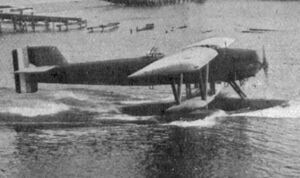Engineering:Besson MB.26
| MB.26 | |
|---|---|

| |
| Role | Reconnaissance or fighter floatplane |
| National origin | France |
| Manufacturer | Besson |
| Designer | Marcel Besson |
| First flight | 1925 |
The Beeson MB.26 was a French sesquiplane floatplane designed by Marcel Besson as a shipborne two-seat reconnaissance aircraft for the French Navy, but it was not ordered into production.[1]
Design and development
The MB.26 was a W-strut wing braced sesquiplane, the upper wing was attached at the top of the fuselage and the lower was below the fuselage.[1] It had one main float under the lower wing and two stabilizing floats on the wingtips.[1] This HB.2 variant was followed by a modified C.2 configuration to turn it into a two-seat fighter seaplane.[1] The C.2 had a new round-sided fuselage, the HB.2 had a slab-sided fuselage, and a new tailplane.[1] Neither variant was ordered or entered production.[1]
Variants
- MB.26 HB.2
- Two-seat reconnaissance seaplane variant.[1]
- MB.26 C.2
- Two-seat fighter seaplane variant.[1]
Operators
 France
France
- French Navy
Specifications (HB.2)
Data from [1] The Illustrated Encyclopedia of Aircraft
General characteristics
- Crew: 2
- Length: 12.10 m (39 ft 8.25 in)
- Wingspan: 15.00 m (49 ft 2.5 in)
- Height: 3.70 m (12 ft 1.25 in)
- Wing area: 52.00 m2 (559.74 sq ft)
- Empty weight: 1,665 kg (3,671 lb)
- Gross weight: 2,415 kg (5,324 lb)
- Powerplant: 1 × Lorraine 12Db inline piston engine , 298 kW (400 hp)
Performance
- Maximum speed: 180 km/h (112 mph, 97 kn)
- Service ceiling: 5,200 m (17,060 ft)
Armament
- One fixed forward-firing 7.7mm (0.303in) machine-gun
- Twin 7.7mm (0.303in) machine-guns on ring-mount at observers cockpit
See also
Related lists
References
Notes
Bibliography
- The Illustrated Encyclopedia of Aircraft (Part Work 1982-1985). Orbis Publishing.
 |

